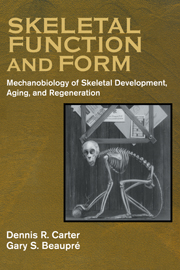Book contents
- Frontmatter
- Contents
- Preface
- Chapter 1 Form and Function
- Chapter 2 Skeletal Tissue Histomorphology and Mechanics
- Chapter 3 Cartilage Differentiation and Growth
- Chapter 4 Perichondral and Periosteal Ossification
- Chapter 5 Endochondral Growth and Ossification
- Chapter 6 Cancellous Bone
- Chapter 7 Skeletal Tissue Regeneration
- Chapter 8 Articular Cartilage Development and Destruction
- Chapter 9 Mechanobiology in Skeletal Evolution
- Chapter 10 The Physical Nature of Living Things
- Appendix A Material Characteristics
- Appendix B Structural Characteristics
- Appendix C Failure Characteristics
- Index
Appendix C - Failure Characteristics
Published online by Cambridge University Press: 11 January 2010
- Frontmatter
- Contents
- Preface
- Chapter 1 Form and Function
- Chapter 2 Skeletal Tissue Histomorphology and Mechanics
- Chapter 3 Cartilage Differentiation and Growth
- Chapter 4 Perichondral and Periosteal Ossification
- Chapter 5 Endochondral Growth and Ossification
- Chapter 6 Cancellous Bone
- Chapter 7 Skeletal Tissue Regeneration
- Chapter 8 Articular Cartilage Development and Destruction
- Chapter 9 Mechanobiology in Skeletal Evolution
- Chapter 10 The Physical Nature of Living Things
- Appendix A Material Characteristics
- Appendix B Structural Characteristics
- Appendix C Failure Characteristics
- Index
Summary
A Simplification of Material Behavior
In Appendix C we present the concepts of mechanical energy, stress and strain histories, failure characteristics, and fatigue damage in skeletal tissues. These topics by themselves are extremely complicated, and we could easily devote a significant portion of the book to their consideration. We and other investigators have addressed the mechanical properties of bone and other tissues extensively in other publications (Carter and Spengler, 1978; Cowin, 1989; Woo, An, et al., 1994; Mow and Hayes, 1997), and the interested reader is referred to these works for a more in-depth treatment of bone and cartilage mechanics.
In the text we discuss tissue mechanics using a very simplified approach. We present a highly idealized view of cartilage and bone, which in the first approximation are isotropic, linear elastic materials. Bone is often viewed here as having approximately the same strength in tension and compression. Cartilage is viewed, in the first approximation, as a single-phase continuum material that is nearly incompressible.
The simplified view of tissue mechanics that we take allows more attention to be given to fundamental aspects of the tissue loading history which are important in skeletal mechanobiology. We believe that our simplifications convey fundamental concepts without distortion. A presentation using more complete tissue characterizations is certainly possible. However, future investigations using more complicated material models will, we believe, build on the ideas that are used here.
Monotonic Material Failure Criteria
When increasingly high forces are applied to a structure such as a bone, the stresses and strains throughout the structure increase. When critically high levels of stress or strain at any location are reached, material failure and fracture will occur at that location.
- Type
- Chapter
- Information
- Skeletal Function and FormMechanobiology of Skeletal Development, Aging, and Regeneration, pp. 292 - 308Publisher: Cambridge University PressPrint publication year: 2000



